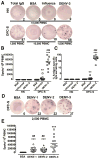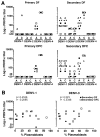Association between magnitude of the virus-specific plasmablast response and disease severity in dengue patients
- PMID: 23203929
- PMCID: PMC3529775
- DOI: 10.4049/jimmunol.1103350
Association between magnitude of the virus-specific plasmablast response and disease severity in dengue patients
Abstract
Dengue is a globally expanding disease caused by infection with dengue virus (DENV) that ranges from febrile illness to acute disease with serious complications. Secondary infection predisposes individuals to more severe disease, and B lymphocytes may play a role in this phenomenon through production of Ab that enhance infection. To better define the acute B cell response during dengue, we analyzed peripheral B cells from an adult Brazilian hospital cohort with primary and secondary DENV infections of varying clinical severity. Circulating B cells in dengue patients were proliferating, activated, and apoptotic relative to individuals with other febrile illnesses. Severe secondary DENV infection was associated with extraordinary peak plasmablast frequencies between 4 and 7 d of illness, averaging 46% and reaching 87% of B cells, significantly greater than those seen in mild illness or primary infections. On average >70% of IgG-secreting cells in individuals with severe secondary DENV infection were DENV specific. Plasmablasts produced Ab that cross-reacted with heterotypic DENV serotypes, but with a 3-fold greater reactivity to DENV-3, the infecting serotype. Plasmablast frequency did not correlate with acute serum-neutralizing Ab titers to any DENV serotype regardless of severity of disease. These findings indicate that massive expansion of DENV-specific and serotype cross-reactive plasmablasts occurs in acute secondary DENV infection of adults in Brazil, which is associated with increasing disease severity.
Figures





References
-
- Simmons CP, Farrar JJ, Nguyenv V, Wills B. Dengue. N Engl J Med. 2012;366:1423–1432. - PubMed
-
- Halstead SB. Dengue. Lancet. 2007;370:1644–1652. - PubMed
-
- Sabin AB. Research on dengue during World War II. Am J Trop Med Hyg. 1952;1:30–50. - PubMed
-
- Burke DS, Nisalak A, Johnson DE, Scott RM. A prospective study of dengue infections in Bangkok. Am J Trop Med Hyg. 1988;38:172–180. - PubMed
-
- Endy TP, Chunsuttiwat S, Nisalak A, Libraty DH, Green S, Rothman AL, Vaughn DW, Ennis FA. Epidemiology of inapparent and symptomatic acute dengue virus infection: a prospective study of primary school children in Kamphaeng Phet, Thailand. Am J Epidemiol. 2002;156:40–51. - PubMed
Publication types
MeSH terms
Grants and funding
LinkOut - more resources
Full Text Sources
Medical

